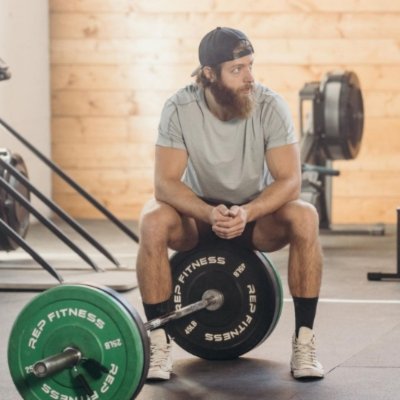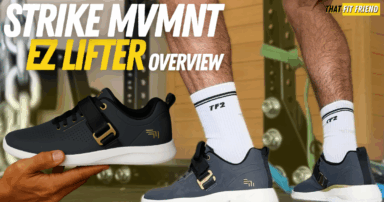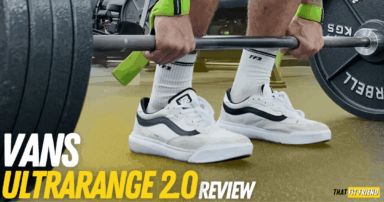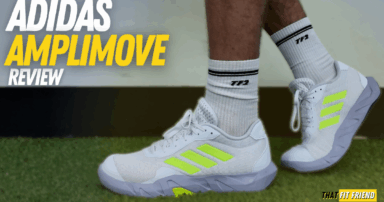The Romanian deadlift (RDL) is one of my favorite exercises to coach. It’s like the barbell deadlift; sometimes, it clicks right away for lifters, and other times, it can be a struggle to nail the form.
Everyone learns differently based on past experiences in sports and strength training, and if there’s one thing I’ve learned over the years of coaching — it’s that no two lifters are alike.
Generally speaking, if I have lifters struggling with the RDL, it’s because of three things:
- Moving through too large of a range of motion and taking tension away from the posterior muscles.
- Flexing the knees too much and taking away posterior muscle tension.
- Being inconsistent with their hinge range of motion and movement pattern.
To fix these form issues, I’ve included three of my favorite RDL hacks that I teach clients below. If you’re struggling with your RDLs, I guarantee you’ll be in a better place to post these tips.
RDL Hack 1: Wall Reference
When to Use It
One of the most common mistakes I see lifters make when performing RDLs is going too deep, which can shift the load away from the target muscles and onto the lower back.
Basically, everyone will have a hip hinge range of motion that is optimal in the context of feeling the hamstrings and glutes. We call this the “productive range of motion” as it’s the most productive for ensuring you’re hitting what you’re trying to train.
How the Wall Reference Works
The wall reference works because it will give you a point of contact for your hinge. For this hack, the goal is to increase your “productive” range of motion by strategically and slowly increasing your distance from the reference — until you hit a point of maximal hip hinge.
When I write maximal, I’m referencing getting the most range of motion that you can realistically handle. We all have limitations with our hinge mechanics and distance based on anatomy, mobility, and strength levels.
- How to Implement:
- Stand about a foot and a half’s length away from the reference point to start.
- Setup and perform your RDL as you normally would, whether it’s with dumbbells, a barbell, or kettlebells.
- Hinge backward until you feel your posterior tap the reference point.
- Once you feel that, stand back up and squeeze your glutes.
For beginners, I recommend starting with a shallower range of motion is recommended. As confidence and form improve, gradually increase the depth to enhance muscle activation. Even if you feel like it’s a short range of motion to start, that’s okay.
Need direction with your training?
I’ve been a strength coach for 12 years and blend strength with athletic-style training. I have a training app that features over 10 programs, and it has a 7-day free trial when you sign up. I build this to be a low-cost option for lifters, cancel at any time!
RDL Hack 2: Front Reference Point
When to Use It
Another common mistake that I see lifters make with the RDL, especially beginners, is flexing the knees too much. When we overly flex the knees, we’re going to shorten the hamstrings, which will place emphasis on the quads and take away emphasis from the hammies.
You often see this with beginners who think the hinge is similar to a squat. You’re flexing your hip a lot in the hinge, but instead of sinking down towards the earth, you’re shifting the hips back to create length through the hamstrings and glutes.
How the Front Reference Works
For this technique, I like to place a band in front of the knees as this will give you a nice proprioceptive cue to not overly flex the knees without making you feel “limited” with your mechanics in the event you do end up flexing — it happens, and it’s normal.
While you’re performing your RDLs, you’ll want to either video yourself from a front-facing angle or stop in between reps to take a peak down. If you’re worried about your form and flexing too much to look down, then do the former. We want to watch for the knees pushing the band at all.
- How to Implement:
- Set up a band or other marker at knee height. I like to use J-hooks on a power rack.
- As you hinge, ensure your knees only lightly touch the band without pushing it forward.
- The goal is to keep that light pressure on the knees and avoid pushing the band forward a ton while hinging.
- Note that you’ll always have some knee flexion when doing RDLs. We’re more interested in a level of flexion that drastically shortens the hamstrings.
You might feel like you’re leaning forward a little more with this method and that’s okay. Try it out for a few weeks to see how your hamstrings respond.
RDL Hack 3: Banded RDLs
When to Use It
If you’re struggling with your hip hinge mechanics or you’re up for a new challenge, that’s when the banded RDL can be a powerful tool. It’s not often we can get an exercise variation that can double as a beginner-friendly teaching tool and a more advanced variation.
How Banded RDLs Work
When doing RDLs and contracting or standing back up, we don’t have a direct load on the glutes as they extend. This doesn’t mean the glutes aren’t working, but it does mean they don’t have the best resistance profile on them. A band around the waist can help with this.
The band will also assist with pulling you deeper into a hinge. This is fantastic for helping you “feel” the stretch from the RDL. It can also help you to move slower against resistance which can improve hip stability and hinge mechanics.
- How to Implement:
- Anchor a band to a power rack at an appropriate height, ensuring it pulls relatively parallel to the ground.
- Step forward away from the rack with the band around waist to create tension in the band.
- You don’t want to be leaning super far forward to stand up. Some lean is perfect and should suffice regarding tension.
- As you perform the RDL, the band helps maintain tension on the hamstrings and introduces additional resistance to the glutes during the concentric (standing) phase.
This setup is excellent for those looking to maximize the benefits of the RDL, particularly for enhancing glute activation.
Tips for Beginners and Advanced Lifters
For beginners:
- Start with lighter weights and a shallower range of motion.
- Focus on mastering the hip hinge and maintaining proper form.
- Gradually increase the range and weight as your strength improves.
For advanced lifters:
- Incorporate the band method to challenge the muscles further.
- Experiment with different stances and foot positions to find the most effective setup.
- Regularly monitor and adjust your form to prevent bad habits from developing.














Add a Comment